

[ MAUKA-MAKAI ]

PHOTOS AND POETRY BY RYAN ARMSTRONG
Ryan Armstrong's image is reflected in a marble marker.
The Marble Reflection
Along the Pilgrim's Path. Did you meet the Daishi? Yes. Everyday.
In taking 50,000 steps every day, Ryan Armstrong developed a profound relationship with his walking stick. It braced him along rocky paths, stabilized slippery ground, pulled him up mountains, negotiated the way down. The religious writings adorning it provided mental exercises during long days. The feel of its smooth wood offered familiarity in the unpredictability of travel. Its every clack, 50,000 times, beat out a rhythm that moved him through another day afoot. The walking stick was Armstrong's companion and partner -- his best friend. In steps of the Buddha
Ryan Armstrong has completed
the Shikoku pilgrimage twiceBy Joleen Oshiro
joshiro@starbulletin.com
As if pulled from a Buddhist parable, Armstrong's pilgrimages to each of the 88 temples on Shikoku, Japan's fourth-largest island, illustrate the Buddhist belief that physical effort is a path to spiritual growth.
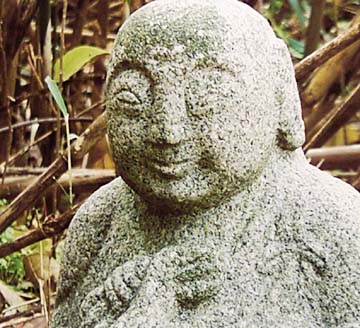
I Am a Happy Jizo
Can you feel the warmth of a cold stone face?
Almost ironically, the path of the pilgrimage begins and ends in the same place. "That's why people refer to it as 'the circle of life,'" Armstrong said.
Armstrong's photographic document of his journey is on display at the Japanese Cultural Center in an exhibit called "The Circle of Life: Shikoku Treasures Through a Pilgrim's Eyes." It runs through July 22.
The nearly 900-mile trek follows the footsteps of Kobo Daishi, a Shingon Buddhist monk who lived during the 13th century. Kobo Daishi, revered as a saint and scholar, was a Renaissance man of sorts. Poet, explorer, artist and healer, he invented the Japanese "kana" syllabary and founded Japanese Buddhism. "Henro," pilgrims who take the journey, don straw hats that provide protection from the elements and carry walking sticks, which represent Kobo Daishi's presence on the trek.
"The phrase 'dogyo ninin' describes the henro and his walking stick," Armstrong said. "It means, 'There go two people,' signifying how Kobo Daishi helps the henro in times of need."
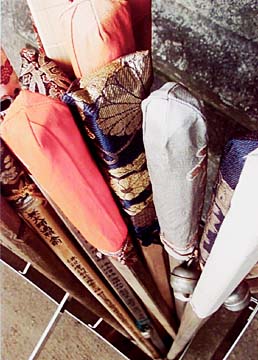
Otsue Collection
My eyes focus on the colors
As the words gradually fade away
To the Henro all is nothing
But the walking stick surpasses all.
For Armstrong, who took the pilgrimage twice, dogyo ninin manifested itself in his growing sense of appreciation.
"The first time, I couldn't really communicate well, and as a consequence some days were real good, others were real bad. The most profound lesson I learned was about kindness," Armstrong said. "There's this word in Japanese, 'osettai,' which usually means wining and dining business clients. But on Shikoku it means giving a gift to a henro without desire for anything in return. There are people who cannot do the pilgrimage for whatever reason -- job, health, whatever -- and this is how they participate.
"One day, I was walking along a road. A man passed me in his car on his way to work in the morning. In the evening that same car passed me again going home. Later, the man drove back to me and gave me a bag of oranges and 1,000 yen for lunch. He said he had seen me while he was going to and from work, and he wanted to help."

Dancers in the Mist
Is this the look of faith?
Armstrong said he received hundreds of dollars in gifts and was invited to bathe and sleep in people's homes. These kindnesses had the power to turn his entire day around.
"I learned the effects simple caring can have on people."
IT WAS WHILE he was a freshman in college that Armstrong first heard about the pilgrimage. It appealed to him immediately.
"A junior spoke to our class about how hard the journey was. And that motivated me," he said. "By the time I was a junior, I had studied Japanese language for six years. Learning Japanese through books is different from really speaking the language. I wanted to learn real Japanese, to meet people and immerse myself in the culture. So I got a professor to agree that instead of taking his class, I could write a paper about the pilgrimage."
In March 1997, Armstrong began his 32-day journey, walking 30 miles a day under the direction of a loose map. His continual search: directional signs for henro.
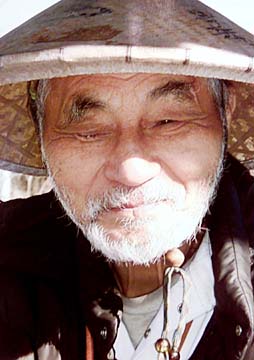
The Henro
Some things are beyond description
This is the look of the Henro.
"The signs had these little stickers on them. If you saw one, you knew you were on the right path. It was like a scavenger hunt, searching for those stickers," he said.
But Armstrong's favorite method was getting lost and meeting people. "I'd see a woman along a path and ask for directions. Then she'd tell me her grandson did the pilgrimage," he said. "My guides wound up being people who live there.
"Ninety-five percent of people do the pilgrimage by bus. Most of what these people see are the temples.
"But when you walk, seeing the temples takes up 1 percent of the time. The rest of the time is spent traveling. It's the journey, not the temples themselves, that make the pilgrimage."
What: "The Circle of Life: Shikoku Treasures Through a Pilgrim's Eyes, 88-Temple Circuit" ON VIEW
Where: Japanese Cultural Center, 2454 S. Beretania St.
When: 10 a.m. to 4 p.m. Tuesdays to Saturdays through July 22
Cost: $3 admission, validated parking
Call: 945-7633
IN JAPANESE BUDDHISM, 108 is a significant number. Humanity, it is believed, bears 108 impurities. Along the pilgrim's 88-temple path in Shikoku are an additional 20 unnumbered temples. By visiting each of the 108 temples, the henro removes one impurity at a time. With each temple visit, the henro is one step closer to enlightenment.
Reflecting the weighty spiritual tasks they're completing, many visitors to the temples carry with them books or scrolls, which are stamped in red to document their visit. The collection of red stamps is so important, many henro take them to the grave, perhaps as proof of their efforts in the life they've passed on from.
The motivations to cleanse impurities are many, Armstrong said. Some henro are ill and seek healing, while others may be doing penance for past misdeeds. Many have faith in Kobo Daishi and make the journey in homage to him. Some simply wish to improve or challenge themselves.
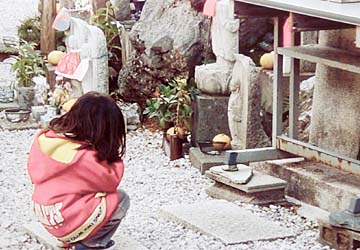
Praying Girl
Small and Petite
Her form a little off
But with one wish in mind
Can anything be more True?
"What's appealing for me is the freedom of it," Armstrong said. "There are no rules. There's no time restriction. You can do it any way you want. You could do 10 temples over 50 years if you wanted."
Perhaps none of the details really matter, because the bottom line for the journey is spiritual development. Armstrong calls it "a pilgrimage of self-discovery."
IT WAS DECEMBER 2000 when Armstrong made his second pilgrimage. In order to challenge himself once more, he decided to do the trek backward, starting from temple 88 and ending at temple one. This meant no henro signs and handy little stickers to mark the way.
But as in the previous journey, Armstrong relied on the guidance of residents along the path. He found that his pilgrim's uniform created opportunities for him to connect with Japanese people in a way he had never been able to before.
"When I wore my regular clothes, people got tense talking to me because I was a foreigner. But on the pilgrimage, with my straw hat and walking stick, I saw the tension disappear from people's faces. I was 'doing' Japanese. We had something in common."
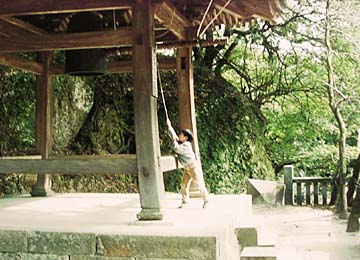
For Whom the Bell Tolls
Mustering his might / An immaculate silence. / Slack, the log let go. / And two connect -- wood with steel / Swept away by rolling tides.
During the first pilgrimage, Armstrong had much more difficulty communicating with residents, so he kept a journal instead.
"That pilgrimage was less about the physical journey than the internal dialogue of my mind and soul in that kind of isolation," he said.
Based on his journal entries, Armstrong decided to take photographs on the second pilgrimage.
"I tried to heighten my awareness of the experience, to harness the emotions of the first journey with the new perspectives of the second one," he said. So in reference to dogyo ninin, the assisting presence of Kobo Daishi, "I took pictures of things that inspired me, gave me energy."
For each photograph, Armstrong then wrote an accompanying poem that conveyed not only information, but emotion.
"I tried to create one experience of the pilgrimage. But, like the quest for enlightenment, no end is ever found. Both journeys are part of one greater journey," he said.
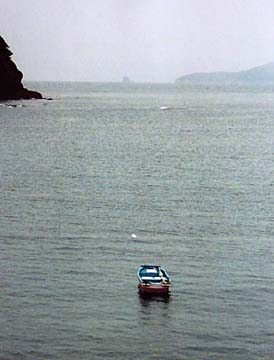
The Lonely Boat
Floating silently on a lonely sea.
I can relate.
Still, there's one fundamental piece of wisdom Armstrong has come away with from his two distinct pilgrimages.
"It all boils down to doing your best to live in the moment," he said. "A happy pilgrim is a happy person. During hard times, I learned to appreciate the small things. The flower on the side of the road, the rainfall.
"I took a picture of my footprints, which were made from my sweat. I appreciated those footprints, thinking, 'In 10 minutes they'll be gone.' Life is fleeting. Catch it while it's there."
Click for online
calendars and events.